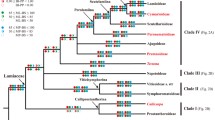Abstract
Oxalis section Articulatae Knuth (Oxalidaceae) comprises a group of five species with a restricted distribution in the southern part of South America. To assess the current circumscription of section Articulatae and the evolutionary mechanisms involved in its diversification, we used three plastid DNA sequences and the nuclear ribosomal transcribed spacer (ITS) to build a molecular phylogeny. A cytogenetic analysis of the group including chromosome number, heterochromatin distribution and determination of nuclear DNA content was also performed. Cytologically, all species presented symmetrical karyotypes except for O. linarantha with a bimodal karyotype although it maintained the same haploid number as the other species (n = 7). Nuclear DNA contents in the Articulatae species are among the lowest for the genus. The O. linarantha 2C value represents the minimum value known for Oxalis, extending the genome size range from 0.58 to 41.10 pg, representing approximately a 70-fold difference, and one of the highest ranges known for an angiosperm genus. Molecular, chromosomal and morphological data suggest that section Articulatae should be redefined to include only those species with rhizomatous stems while the tunicate-bulbous species O. linarantha should be placed elsewhere. Different ploidy levels were found, ranging from 2x to 7x. Diploids and polyploids showed a geographic structure; diploids are widely distributed, while polyploids are found in the uplands of eastern Uruguay and southern Brazil. Haplotype sharing and chromosome data suggest that at least some of section Articulatae polyploids may be the result of interspecific hybridization and appear to have originated very recently.






Similar content being viewed by others
References
Bandelt H-J, Forster P, Röhl A (1999) Median-joining networks for inferring intraspecific phylogenies. Molec Biol Evol 16:37–48
Cabral JS, Felix LP, Guerra M (2006) Heterochromatin diversity and its co-localization with 5S and 45S rDNA sites in chromosomes of four Maxillaria species (Orchidaceae). Genet Molec Biol 29:659–664
Castro S, Loureiro J, Santos C, Ater M, Garbine A, Navarro L (2007) Distribution of flower morphs, ploidy level and sexual reproduction of the invasive weed Oxalis pes-caprae in the western area of the Mediterranean region. Ann Bot (Oxford) 99:507–517. doi:10.1093/aob/mcl273
de Azkue D (2000) Chromosome diversity of South American Oxalis. Bot J Linn Soc 132:143–152. doi:10.1006/bojl.1999.0291
Doležel J, Göhde W (1995) Sex determination in dioecious plants Melandrium album and M. rubrum using high-resolution flow cytometry. Cytometry 19:103–106
Doležel J, Greilhuber J, Suda J (2007) Estimation of nuclear DNA content in plants using flow cytometry. Nat Protoc 2:2233–2244. doi:10.1038/nprot.2007.310
Doyle JJ, Doyle JL (1987) A rapid DNA isolation procedure for small quantities of fresh leaf tissue. Phytochem Bull Bot Soc Am 19:11–15
Eckert AJ, Carstens BC (2008) Does gene flow destroy phylogenetic signal? The performance of three methods for estimating species phylogenies in the presence of gene flow. Molec Phylogen Evol 49:832–842. doi:10.1016/j.ympev.2008.09.008
Emshwiller E (2002) Biogeography of the Oxalis tuberosa alliance. Bot Rev 68:128–152. doi:10.3732/ajb.89.7.1042
Emshwiller E, Doyle JJ (2002) Origins of domestication and polyploidy in Oca (Oxalis tuberosa: Oxalidaceae). 2. Chloroplast expressed glutamine synthetase data. Amer J Bot 89:1042–1056. doi:10.3732/ajb.89.7.1042
Emshwiller E, Terra T, Grau A, Nina V, Terrazas F (2009) Origins of domestication and polyploidy in oca (Oxalis tuberosa: Oxalidaceae) 3: AFLP data of oca and four wild, tuber-bearing taxa. Amer J Bot 96:1839–1848. doi:10.3732/ajb.0800359
Estelita-Texeira ME (1982) Shoot anatomy of three bulbous species of Oxalis. Ann Bot (Oxford) 49:805–813
Gardner A, Vaio M, Guerra M, Emshwiller E (2012) Diversification of the American bulb-bearing Oxalis (Oxalidaceae): Dispersal to North America and modification of the tristylous breeding system. Amer J Bot 99:152–164. doi:10.3732/ajb.1100152
Grant V (1981) Plant speciation, 2nd edn. Columbia University Press, New York
Grigoletto D, Bertuzzi T, Eisinger SM, Scotti do Canto-Dorow T, Schneider Colusso C (2014) O gênero Oxalis L. (Oxalidaceae) no Rio Grande do Sul. Ciência e Natura, Santa Maria 36:594–612. doi:10.5902/2179460X13220
Groves RH, Boden R, Lonsdale WM (2005) Jumping the garden fence invasive garden plants in Australia and their environmental and agricultural impacts. CSIRO report prepared for WWF-Australia, Sydney
Guindon S, Gascuel O (2003) A simple, fast, and accurate algorithm to estimate large phylogenies by maximum likelihood. Syst Biol 52:696–704. doi:10.1080/10635150390235520
Hall TA (1999) BioEdit: a user-friendly biological sequence alignment editor and analysis program for Windows 95/98/NT. Nucl Acids Symp Ser 41:95–98
Heibl C, Renner S (2012) Distribution models and a dated phylogeny for Chilean Oxalis species reveal occupation of new habitats by different lineages, not rapid adaptive radiation. Syst Biol 61:823–834. doi:10.1093/sysbio/sys034
Heitz E (1927) Über multiple und aberrante chromosomzahlen. Abh. Geb. Nature 21:47
Knuth R (1930) Oxalidaceae. In: Engler A (ed.) Das Pflanzenreich. IV 130, Leipzig, 481pp
Krejčíková J, Sudová R, Lučanová M, Trávníček P, Urfus T, Vít P, Weiss-Schneeweiss H, Kolano B, Oberlander K, Dreyer LL, Suda J (2013) High ploidy diversity and distinct patterns of cytotype distribution in a widespread species of Oxalis in the Greater Cape Floristic Region. Ann Bot (Oxford) 111:641–649. doi:10.1093/aob/mct030
Lourteig A (1982) Oxalidaceae extra-austroamericanae IV: Oxalis L. sectio Articulatae Knuth. Phytologia 30:130–142
Lourteig A (1983) Oxalidaceae. In: Reitz R (ed) Flora ilustrada catarinense, pp 3–174
Lourteig A (2000) Oxalis L. subgénero Monoxalis (Small) Lourteig, Oxalis y Trifidus Lourteig. Bradea 7:201–629
Marks GE (1956) Chromosome numbers in the genus Oxalis. New Phytol 55:120–126
Melo NF, Guerra M (2003) Variability of the 5S and rDNA sites in Passiflora L. with species with distinct base chromosome numbers. Ann Bot (Oxford) 92:309–316. doi:10.1093/aob/mcg138
Mori GM, Zucchi MI, Sampaio I, Souza AP (2015) Species distribution and introgressive hybridization of two Avicennia species from the Western Hemisphere unveiled by phylogeographic patterns. BMC Evol Biol 15:61. doi:10.1186/s12862-015-0343-z
Naranjo CA, Mola LM, Poggio L, Múlgura M (1982) Estudios citotaxonómicos y evolutivos de Oxalis (Oxalidaceae) I. Bol Soc Argent Bot 20:183–200
Nesom GL (2009) Taxonomic notes on acaulescent Oxalis (Oxalidaceae) in the United States. Phytologia 91:501–526
Oberlander KC, Dreyer LL, Bellstedt DU, Reeves G (2004) Systematic relationships in southern African Oxalis L. (Oxalidaceae): congruence between palynological and plastid trnL-F evidence. Taxon 53:977–985
Oberlander KC, Emshwiller E, Bellstedt DU, Dreyer LL (2009) A model of bulb evolution in the eudicot genus Oxalis (Oxalidaceae). Molec Phylogen Evol 51:54–63. doi:10.1016/j.ympev.2008.11.022
Oberlander KC, Dreyer LL, Bellstedt DU (2011) Molecular phylogenetics and origins of southern African Oxalis. Taxon 60:1667–1677
Page RDM (1996) TREEVIEW: an application to display phylogenetic trees on personal computers. Comput Appl Biosci 12:357–358
Pedrosa A, Sandal N, Stougaard J, Schweizer D, Bachmair A (2002) chromosomal map of the model legume Lotus japonicus. Genetics 161:1661–1672
Posada D (2008) jModelTest: phylogenetic model averaging. Molec Biol Evol 25:1253–1256. doi:10.1093/molbev/msn083
Rambaut (2009) FigTree, tree figure drawing tool v 1.3.1. http://tree.bio.ed.ac.uk/software/figtree
Roa F, Guerra M (2015) Non-random distribution of 5S rDNA sites and its association with 45S rDNA in plant chromosomes. Cytogenet Genome Res 146:243–249. doi:10.1159/000440930
Ronquist F, Huelsenbeck JP (2003) MRBAYES 3: Bayesian phylogenetic inference under mixed models. Bioinformatics 19:1572–1574
Salter TM (1944) The genus Oxalis in South Africa: a taxonomic revision. J South Afr Bot. Supplemental Edition, vol 1. Cape Times Limited, Cape Town
Schmickl R, Liston A, Zeisek V, Oberlander K, Witemier K, Straub SCK, Cronn RC, Dreyer LL, Suda J (2015) Phylogenetic marker development for target enrichment from transcriptome and genome skim data: the pipeline and its application in southern African Oxalis (Oxalidaceae). Molec Ecol. doi:10.1111/1755-0998.12487
Shaw J, Lickey EB, Schilling EE, Small RL (2007) Comparison of whole chloroplast genome sequences to choose noncoding regions for phylogenetic studies in angiosperms: the tortoise and the hare III. Amer J Bot 94:275–288. doi:10.3732/ajb.94.3.275
Speranza PR, Seijo JG, Grela IA, Solís-Neffa VG (2007) Chloroplast DNA variation in the Turnera sidoides L. complex (Turneraceae): biogeographical implications. J Biogeogr 34:427–436. doi:10.1111/j.1365-2699.2006.01622.x
Suda J, Krejčíková J, Sudová R, Oberlander K, Dreyer LL (2013) Two new species of Oxalis (Oxalidaceae) from the Greater Cape Floristic Region. Phytotaxa 124:13–24
Taberlet PL, Geilly G, Bouvet J (1991) Universal primers for amplification on three non-coding regions of chloroplast DNA. Pl Molec Biol 17:1105–1109
Thompson JD, Higgins DG, Gibson TJ (1994) CLUSTAL W: improving the sensitivity of progressive multiple sequence alignment through sequence weighting, position specific gap penalties and weight matrix choice. Nucl Acid Res 22:4673–4680
Vaio M (2012) Relações filogenéticas e evolução cromossômica em espécies do gênero Oxalis (Oxalidaceae). PhD Thesis. Universidade Federal de Pernambuco, Programa de Pós-Graduação em Biologia Vegetal, Brazil
Vaio M, Speranza P, Valls JF, Guerra M, Mazzella C (2005) Localization of the 5S and 45S rDNA sites and cpDNA sequence analysis in species of the Quadrifaria group of Paspalum (Poaceae, Paniceae). Ann Bot (Oxford) 96:191–200. doi:10.1093/aob/mci168
Vaio M, Gardner A, Emshwiller E, Guerra M (2013) Molecular phylogeny and chromosome evolution among the creeping herbaceous Oxalis species of sections Corniculatae and Ripariae (Oxalidaceae). Molec Phylogen Evol 68:199–211. doi:10.1016/j.ympev.2013.03.019
Wanzenböck E-M, Schöfer C, Schweizer D, Bachmair A (1997) Ribosomal transcription units integrated via T-DNA transformation associate with the nucleolus and do not require upstream repeat sequences for activity in Arabidopsis thaliana. Pl J 11:1007–1016. doi:10.1046/j.1365-313X.1997.11051007.x
Wendel JF (2000) Genome evolution in polyploids. Pl Molec Biol 42:225–249. doi:10.1023/A:1006392424384
White TJ, Bruns T, Lee S, Taylor J (1990) Amplification and direct sequencing of fungal ribosomal RNA genes for phylogenetics. In: Innis M, Gelfand D, Sninsky J, White T (eds) PCR protocols: a guide to methods and applications. Academic Press, San Diego, pp 315–322
Wolfe KH (2001) Yesterday’s polyploidization and mystery of diploidization. Nat Rev Genet 2:333–341. doi:10.1038/35072009
Young DP (1958) Oxalis in the British Isles. Watsonia 4:51–69
Yu J, Kuroda C, Gong X (2014) Natural hybridization and introgression between Ligularia cymbulifera and L. tongolensis (Asteraceae, Senecioneae) in four different locations. PLoS One 9(12):e115167. doi:10.1371/journal.pone.0115167
Acknowledgments
This work was supported by grants funded by Conselho Nacional de Pesquisas (CNPq) and Coordenação de Aperfeiçoamento de Pessoal de Nível Superior (CAPES), Brazil. We are also grateful to the Program “Programa de Estudante Convenio-Posgraduação” (PEC-PG, Brazil), the Systematic Research Fund -SRF (The Linnean Society of London) and the InterAmerican Network of Academies of Science (IANAS fellowships, USA) for fellowships to MV. EE acknowledges support of grant DEB 1027270 from the National Science Foundation of the USA. We would like to thank Dr. Eduardo Marchesi for the aid in plant identification, Drs. Pedro Fiaschi and Leonardo Pessoa Félix for sampling support and assistance in the field. We are especially grateful to Dr. Pedro Fiaschi for the O. linarantha bulb and bulb dissection images. We also thank the two anonymous reviewers for all the helpful comments on the manuscript.
Author information
Authors and Affiliations
Corresponding author
Ethics declarations
Conflict of interest
The authors declare that they have no conflict of interest.
Additional information
Handling editor: Martin Lysak.
Electronic supplementary material
Below is the link to the electronic supplementary material.
Information on Electronic Supplementary Material
Information on Electronic Supplementary Material
Two Online Resources are available.
Online Resource 1. Complete list and information of all accessions analyzed.
Online Resource 2. List of all GenBank accession numbers.
Rights and permissions
About this article
Cite this article
Vaio, M., Gardner, A., Speranza, P. et al. Phylogenetic and cytogenetic relationships among species of Oxalis section Articulatae (Oxalidaceae). Plant Syst Evol 302, 1253–1265 (2016). https://doi.org/10.1007/s00606-016-1330-6
Received:
Accepted:
Published:
Issue Date:
DOI: https://doi.org/10.1007/s00606-016-1330-6




